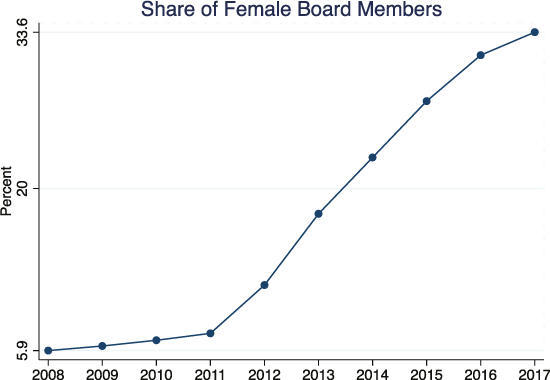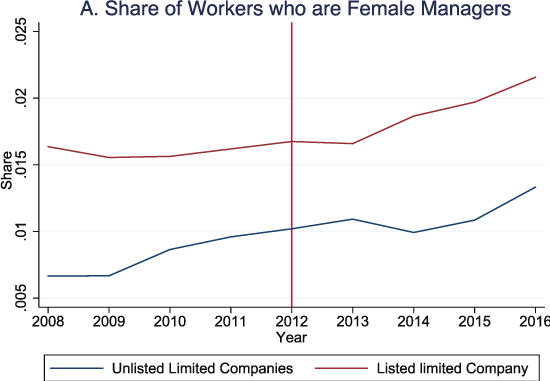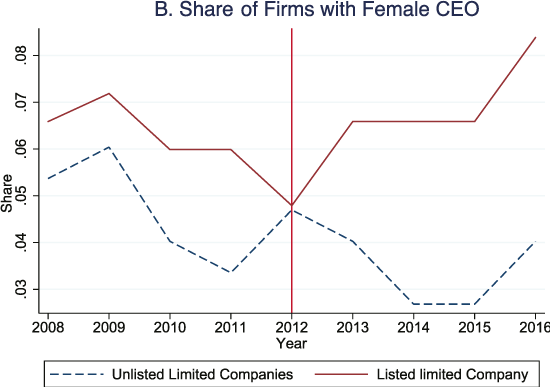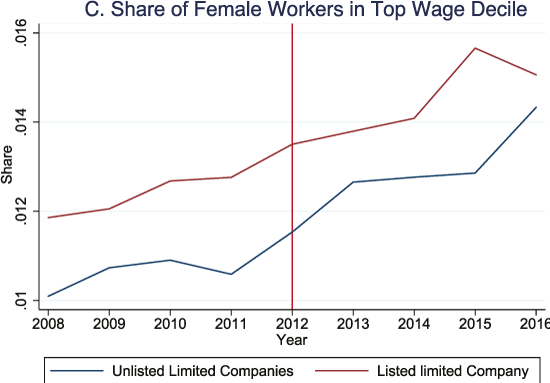Women make up almost half of the labour force, but the higher we go in the earnings distribution, the fewer women we encounter. They are also severely under-represented in leadership positions. In an attempt to break this glass ceiling, some suggest mandated gender quotas. In 2003 Norway was the first country to pass a law requiring a minimum of 40% of each gender on the board of directors of public limited companies. Since then, Austria, Belgium, Denmark, France, Ireland, Iceland, Italy, Germany, the Netherlands and Spain have adopted similar regulations.
Gender quota laws are generally successful in raising the number of female members on corporate boards. By 2016 female board membership of large listed companies in the EU has increased to 23%, from 12% in 2010. It is less clear, though, whether gender quota laws also have an impact on women who are not on corporate boards.
Matsa and Miller (2011) show that US companies with higher shares of female board members are more likely to hire a female top executive. But it is not entirely clear whether this is a causal link, or whether unobserved factors drive both outcomes. Bertrand et al. (2019) exploit quasi-experimental variation from Norwegian law and find no evidence that the quota regulation has benefited other women who are employed in companies subject to the quota. They do not find an impact on highly qualified women either.
Studying board membership in Italy
In our recent research (Maida and Weber 2019) we evaluate the Italian law of 2011, which created a stepwise increase in board gender quotas that remain effective for three consecutive board renewals of listed limited liability firms. Our research is based on detailed data that link firm-level information on board membership and board election dates to individual-level employment and earnings records. These data have recently been made available by the Italian Social Security Institute (INPS) through the VisitINPS scholar programme.
We exploit the staggered introduction of the gender quota regulation, and variation in board renewals across firms, to evaluate the effect of board gender composition on measures of gender diversity in top positions over four years.
As in other countries, Italian listed companies complied swiftly with the gender quota once the law was implemented. The number of board seats taken by women increased four-fold between 2011 and 2017 (figure 1). We also find evidence that companies appreciated the gradual introduction of the quota regulation: some of them responded in anticipation of the law and started raising their gender quotas at board elections scheduled in 2012, which was before the law became binding.
Figure 1 Share of female board members in Italian listed limited liability firms, 2008-2017
Source: INPS.
Trickle-down effects of female board representation
Turning to the effects of this sharp increase of female representation on boards of directors on several measures of gender gaps in the workforce, we find no evidence that the mandated female board quota translated into an increase in female representation at the top executive level, or among top earners – at least not in the short run.
Figures 2-4 compare female outcomes in listed limited firms that were subject to the law with outcomes in a matched comparison group of non-listed limited firms that were unaffected by the law.
Figure 2 Share of workers in Italian limited liability firms who were female managers, 2008-2016
Source: INPS.
Generally, the share of the overall workforce who are female managers is below 2% and slightly increasing over time in both groups of firms. But there is no noticeable change in listed firms after 2012 that would indicate reform effects. Figure 3 suggests that listed companies were more likely to promote one of their female managers as a CEO after the reform.
Figure 3 Share of Italian limited liability firms with a female CEO, 2008-2016
Source: INPS.
But these promotions did not lead to a higher representation of women among top earners in the company, as shown in Figure 4.
Figure 4 Share of female workers in Italian limited liability firms in top wage decile, 2008-2016
Source: INPS.
We did an additional heterogeneity analysis using the pre-reform share of female board members. New appointments of female CEOs occurred only in companies that already fulfilled the female quota in 2012, which is further evidence against wider reform effects. Looking at a broader set of female outcome measures, we find no evidence of changes in the overall gender workforce composition due to the reform.
Our findings are in line with the evidence for Norway by Bertrand et al. (2019). Even though Italy has lower female labour force participation, higher gender wage gaps, and lower representation of women in the top of the earnings distribution than Norway, the strict enforcement of gender ratios does not lead to changes in the overall labour market situation of women.
Explaining the lack of trickle-down effects
There are several potential explanations:
- There are few high-profile positions created by the reform. In 2017, when the law was almost fully implemented, 758 director position in Italy were filled by women. Compared to the overall market of highly qualified women in the country, this seems a symbolic number that suggests that the coverage of the law should be extended to a much wider range of companies.
- If the wider effects work through changes in perception and social norms, our analysis of short-term effects might not capture the full extent of the law's impact. But if norms respond slowly, we should question the usefulness of a temporary law (the Italian law is scheduled to expire after the third round of board elections).
- Newly appointed female board members might not be in powerful positions that allow them to influence changes at the firm level. Rebérioux and Roudaut (2016) show that newly appointed females on boards of French companies are less likely to hold key positions than their male counterparts, which weakens any potential positive effects of gender quota.
More equal female representation on corporate boards is desirable, but our findings suggest that a gender quota alone is not an effective tool to reduce gender disparities within firms. This is especially true in Italy, with its traditional gender culture. We agree with Smith (2016), who provides a broader picture of the pros and cons of gender quotas on boards of directors, and concludes that “policymakers may have to change their focus from requiring quotas for the top of an organisation to the much broader task of getting a more balanced gender division of careers within the family.”
References
Bertrand M, S E Black, S Jensen and A Lleras-Muney (2019), “Breaking the Glass Ceiling? The Effect of Board Quotas on Female Labour Market Outcomes in Norway”, The Review of Economic Studies 86(1): 191-239.
Maida, A and A Weber (2019), “Female Leadership and Gender Gap within Firms: Evidence from an Italian Board Reform”, CEPR Discussion Paper 13476.
Matsa, D A, and A R Miller (2011), "Chipping Away at the Glass Ceiling: Gender Spillovers in Corporate Leadership", American Economic Review 101(3): 635–639.
Rebérioux, A and G Roudaut (2016), “Gender Quota inside the Boardroom: Female Directors as New Key Players?” CEPREMAP working paper 1603.
Smith, N (2018), “Gender quotas on boards of directors”, IZA World of Labour 2018: 7.








